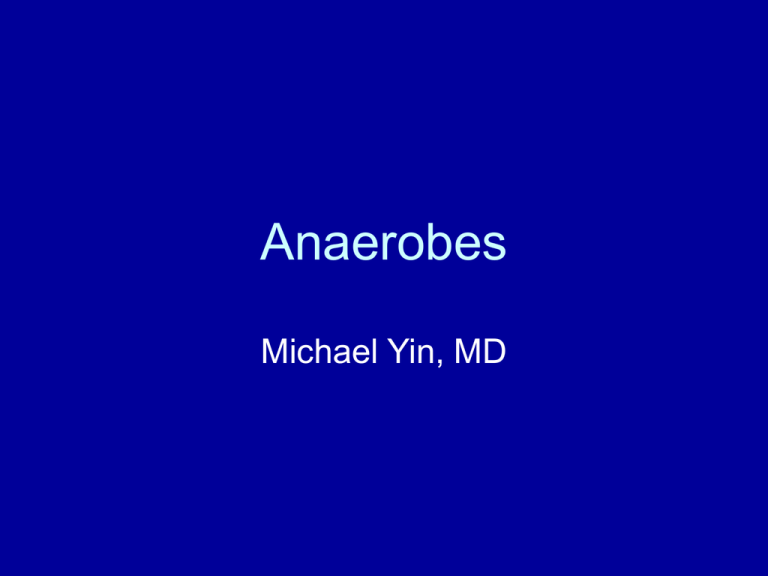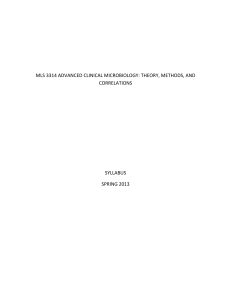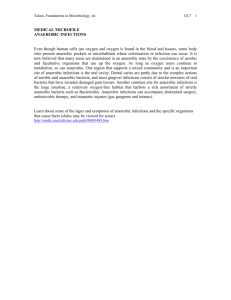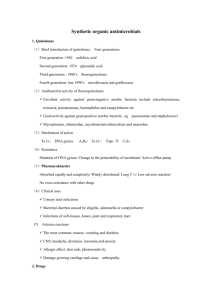Anaerobes
advertisement

Anaerobes Michael Yin, MD Definitions • Anaerobes – Bacteria that require anaerobic conditions to initiate and sustain growth • Strict (obligate) anaerobe – Unable to grow if > than 0.5% oxygen • Moderate anaerobes – Capable of growing between 2-8% oxygen • Microaerophillic bacteria – Grows poorly in air, but better in anaerobic conditions • Facultative bacteria (facultative anaerobes) – Grows both in presence and absence of air Classification of Medically Important Anaerobes • Gram positive cocci – Peptostreptococcus • Gram negative cocci – Veillonella • Gram positive bacilli – – – – – Clostridium perfringens, tetani, botulinum, difficile Propionibacterium Actinomyces Lactobacillus Mobiluncus • Gram negative bacilli – – – – Bacteroides fragilis, thetaiotaomicron Fusobacterium Prevotella Porphyromonas Epidemiology • Endogenous infections – Indigenous microflora • Skin: Propionibacterium, Peptostreptococcus – Prevalence in areas exposed to air explained by (1) oxygen consumption by aerobes (2) low oxidation-reduction potential microhabitats • • • • Upper respiratory: Propionibacterium Mouth: Fusobacterium, Actinomyces Intestines: Clostridium, Bacteroides, Fusobacterium Vagina: Lactobacillus – Profound modification of flora in pathophysiologic states • Antimicrobials and other medications (PPI, antacids) • Surgery (blind loops) • Cancers • Exogenous infections Role of Anaerobes • Role in normal host physiology – Prevent colonization & infection by pathogens • Bacterial interference through elaboration of toxic metabolites, low pH, depletion of nutrients • Interference with adhesion – Contributes to host physiology • B. fragilis synthesizes vitamin K and deconjugates bile acids Sites of anaerobic infections Virulence factors • Attachment and adhesion – Polysaccharide capsules and pili • Invasion – Alteration in host tissue (trauma, disease) – Aerotolerance • Establishment of infection – Polysaccharide capsule (B. fragilis) – Spore formation (Clostridium) – Maintenance of reduced environment • Tissue damage – Elaboration of toxins Clinical features of anaerobic infections • The source of infecting micro-organism is the endogenous flora of host • Alterations of host’s tissues provide suitable conditions for development of opportunist anaerobic infections • Anaerobic infections are generally polymicrobial • Abscess formation • Exotoxin formation Anaerobic cocci • Epidemiology – Normal flora of skin, mouth, intestinal and genitourinary tracts • Pathogenesis – Opportunistic pathogens, often involved in polymicrobial infections – Virulence factors not as well characterized – Brain abscesses, periodontal disease, pneumonias, skin and soft tissue infections, intra-abdominal infections • Peptostreptococcus – P. magnus: chronic bone and joint infections, especially prosthetic joints – P. prevotti and P. anaerobius: female genital tract and intraabdominal infections • Veillonella – Normal oral flora; isolated from infected human bites Anaerobic gram positive bacilli • No Spore Formation – Propionibacterium • P. acnes – Actinomyces • A. israelii – Lactobacillus – Mobiluncus • Spore Formation – Clostridium • • • • C. perfringens C. difficile C. tetani C. botulinum Propionobacterium • Anaerobic or aerotolerant, produces propionic acid as major byproduct of fermentation • Colonize skin, conjunctiva, external ear, oropharynx, female GU tract • P. acnes – Acne • Resides in sebaceous follicles, releases LMW peptide, stimulates an inflammatory response – Opportunistic infections • Prosthetic devices (heart valves, CSF shunts) Actinomyces • Facultative or strict anaerobes • Colonize upper respiratory tract, GI, female GU tract • Low virulence; development of disease when normal mucosal barriers are disrupted • Diagnosis: – Macroscopic colonies of organisms resembling grains of sand (sulfur granules) – Culture Actinomycosis • Cervicofacial Actinomycosis – Poor oral hygiene, oral trauma – Slowly evolving, painless process – Chronic granulomatous lesions that become suppurative and form sinus tracts – Treatment: surgical debridement and prolonged penicillin Lactobacillus • Facultative or strict anaerobes • Colonize GI and GU tract – Produces H2O2 which is bactericidal to Gardnerella vaginalis – Vagina heavily colonized (105/ml) by Lactobacillus crispatus & jensonii • Clinical disease – Transient bacteremia from GU source – Endocarditis – Bacteremia in immunocompromized host Mobiluncus • • • • Obligate anaerobes Gram negative or gram variable Colonize GU tract in low numbers Associated with bacterial vaginosis – Detected in vagina of 6% of controls – As many as 97% of women with bacterial vaginosis Clostridium • Epidemiology – Ubiquitous, • Present in soil, water, sewage • Normal flora in GI tracts of animals and humans • Pathogenesis – Spore formation • resistant to heat, dessication, and disinfectants • can survive for years in adverse environments – Rapid growth in nutritionally enriched, oxygen deprived environment – Toxin elaboration (histolytic toxins, enterotoxins, neurotoxins) Clostridium perfringens • Epidemiology – GI tract of humans and animals – Type A responsible for most human infections • Pathogenesis – α-toxin: lecithinase (phospholipase C) that lyses erythrocytes, platelets and endothelial cells – ß-toxin: necrotizing activity – θ-toxin: hemolysin – Enterotoxin: binds to brush borders and disrupts small intestinal transport • Clinical manifestations – Self-limited gastroenteritis – Soft tissue infections: cellulitis, fascitis or Myonecrosis (gas gangrene) Clostridial soft tissue infections Crepitant cellulitis Fascitis Myonecrosis Myonecrosis Myonecrosis xray Clostridial myonecrosis • Clinical course – <48 hours incubation – Local area with marked pain, swelling, serosanguinous discharge, bullae, slight crepitance – May be associated with increased CPK • Treatment – Surgical debridement – Antibiotics – Hyperbaric oxygen Clostridium difficile • Epidemiology – Colonizes GI tract of 5% healthy individuals – Endogenous infection • antibiotic exposure associated with overgrowth of C. difficile – Exogenous infection • spores detected in hospital rooms of infected patients • Pathogenesis – Enterotoxin (toxin A) • produces chemotaxis, induces cytokine production and hypersecretion of fluid, development of hemorrhagic necrosis – Cytotoxin (toxin B) • Induces polymerization of actin with loss of cellular cytoskeleton C. difficile colitis C. difficile colitis • Clinical syndromes – Asymptomatic colonization – Antibiotic-associated diarrhea – Pseudomembranous colitis • Diagnosis – Isolation of cytotoxin or enterotoxin • Treatment – Discontinue antibiotics – Metronidazole or vancomycin – Relapse in 20-30% (spores are resistant) Clostridium tetani • Epidemiology – Spores found in most soils – Disease in un-vaccinated or inadequately immunized – Disease does not induce immunity • Pathogenesis – Spore inoculated into wound – Tetanospasmin • Heat-labile neurotoxin • Retrograde axonal transport to CNS • Blocks release of inhibitory neurotransmitters (GABA) resulting in spastic paralysis • Binding is irreversible – Tetanolysin • Oxygen labile hemolysin, unclear clinical significance C. tetani exotoxin Tetanus • Clinical Manifestations – Generalized • Involvement of bulbar and paraspinal muscles – Trismus, risus sardonicus, opisthotonos • Autonomic involvement – Sweating, hyperthermia, cardiac arrythmias, labile BP – Cephalic • Involvement of cranial nerves only – Localized • Involvement of muscles in primary are of injury – Neonatal • Generalized in neonates; infected umbilical stump Risus sardonicus and Opisthotonos of Tetanus Tetanus • Treatment – Debridement of wound – Metronidazole – Tetanus immunoglobulin – Vaccination with tetanus toxoid • Prevention – Vaccination with a series of 3 tetanus toxoid – Booster dose every 10 years Clostridium botulinum • Epidemiology – Commonly isolated in soil and water – Human disease associated with A, B, E, F • Pathogenesis – Botulinum toxin targets cholinergic nerves – Prevents release of acetylcholine – Recovery depends upon regeneration of nerve endings C. Botulinum Exotoxin Botulism • Clinical Syndromes – Foodborne botulism • Mostly associated with home-canned foods and preformed toxin • Onset of symptoms 1-2 days: blurred vision, dilated pupils, dry mouth, constipation • Bilateral descending weakness of peripheral muscles; death related to respiratory failure – Infant botulism • Consumption of foods contaminated with botulinum spores • Disease associated with neurotoxin produced in vivo – Wound botulism Botulism • Diagnosis – Isolation of organism • Culture implicated food and stool of patient – Isolation of toxin • Mouse bioassay • Treatment – Supportive care – Elimination of organism from GI tract • Gastric lavage • Metronidazole or penicillin – Trivalent botulinum toxin (A, B, E) to bind circulating botulinum toxin • Prevention – Prevention of spore germination (Acid PH, storage <4°C) – Destruction of preformed toxin (20 min at 80°C) Anaerobic gram negative bacilli • Bacteroides – B. fragilis – B. thetaiotaomicron • Fusobacterium • Prevotella • Porphyromonas Anaerobic gram negative bacilli • Epidemiology – Colonize human body in great numbers • Stabilize resident bacterial flora • Prevent colonization by pathogens – Anaerobes are predominant bacteria in upper respiratory tract, GI and GU tract • Outnumber aerobic bacteria by 10-100 fold • Many species, but few pathogens Anaerobic gram negative bacilli • Clinical Diseases – Chronic sinus infections – Periodontal infections – Brain abscess – Intra-abdominal infection – Gynecological infection – Skin and soft tissue Bacteroides • Epidemiology – B. fragilis associated with 80% of intra-abd infx • Pathogenesis – Polysaccharide capsule • Increases adhesion to peritoneal surfaces (along with fimbriae) • Protection against phagocytosis • Differs from LPS of aerobic GNR – Less fatty acids linked to Lipid A component – Less pyrogenic activity – Superoxide dismutase and catalase – Elaborate a variety of enzymes Bacteroides • Infections – Intra-abdominal infections (peritonitis, abscess); bacteremias; decubitus and diabetic ulcers • Treatment – Drainage of abscess and debridement of necrotic tissue – Antibiotics





